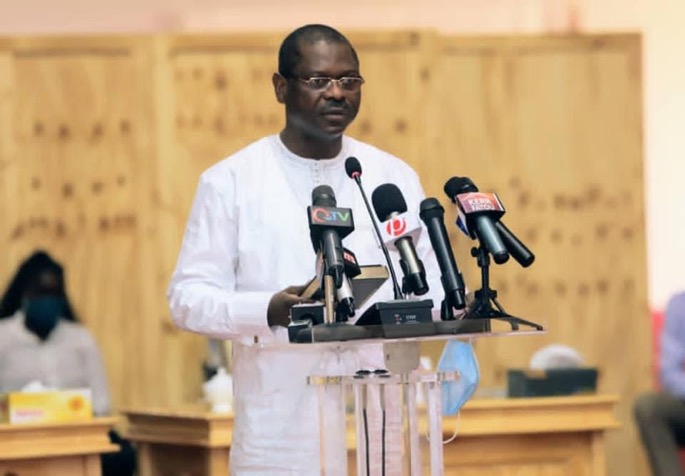Finance Minister Reports Gambia’s Debt Surged from D46.3 Billion in 2016 to D110.6 Billion in 2023

By Landing Ceesay
Finance Minister Seedy Keita has unveiled to reporters that The Gambia’s overall debt has surged from D46.3 billion in 2016 to D110.6 billion by 2023.
Keita attributed this considerable increase to several factors: inheriting substantial domestic and foreign debts from the previous administration, expensive domestic debt servicing, substantial contingent liabilities from entities like NAWEC and loss-making State Owned Enterprises (SOEs), debt restructuring during the COVID-19 pandemic, dalasi depreciation against major currencies, and new borrowing for ongoing development ventures.
“The Gambia’s total debt stock increased from D46.3 billion in 2016 to D110.6 billion in 2023, largely attributed to inherited large domestic and external debt from the previous administration; costly domestic debt service obligations; high contingent liabilities stemming primarily from NAWEC and several loss-making State Owned Enterprises (SOEs); debt restructuring during the outbreak of COVID-19; the depreciation of the dalasi against major currencies; and new borrowing 59 finance ongoing development projects,” Finance Minister revealed. Breaking down the figures, Keita outlined that in 2018, the total debt stood at D68.9 billion, with D32.5 billion in domestic debt and D36.4 billion in external debt. By 2019, the total debt had risen to D73.9 billion, with D33.1 billion in domestic debt and D40.9 billion in external debt. In 2020, the debt further escalated to D78.7 billion, comprising D33.1 billion domestic and D45.7 billion external debt. For the 2021 fiscal year, the total debt climbed to D86.7 billion, split into D36.6 billion domestic and D50.1 billion external debt. Moving to 2022, the total debt reached D100.6 billion, with D37.4 billion domestic and D63.2 billion external debt. Finally, in the 2023 fiscal year, the total debt peaked at D110.6 billion, with D42.0 billion domestic and D68.7 billion external debt.
“Between 2018 and 2020, the Gambia’s domestic debt stock did not change much. The change in total public debt stock results from external debt restructuring and the depreciation of the Gambian dalasi against major currencies. Following the outbreak of COVID-19, the Gambia secured commitments to restructure Its bilateral and multilateral debt to alleviate the country’s debt service burden,” Hon. Keita said. The Finance Minister highlighted that restructuring debt relieves immediate fiscal pressure from debt service payments. Hon. Keita further explained that as external debt disbursements continue, the total debt stock rises, while payments towards debt principal are postponed.
“In 2017, the administration inherited an overdrawn TMA to the tune of D10.8 billion. This was subsequently securitized by issuing a 30-year non-marketable bond. In 2018, the new government signed an MOU agreeing to assume the majority of NAWEC’s debt and issued a 7-year non-marketable NAWEC bond up to the tune of D1.7 billion to make debt service payments on behalf of the national utility provider.
“These led to an increased domestic debt stock from D21.8 billion in 2016 to D32.5 billion in 2018. Similarly, the new administration inherited a legacy debt of USD50. 4 million (roughly GMD 2.4 billion) arising from confirmed debt in infrastructure contracts by the previous regime. New Borrowing (projects and new domestic borrowings) equivalent to D41.9 billion,” Hon. Keita revealed.
The Finance Minister announced that the recent debts were allocated to fund various initiatives, including the construction of the new Bertil Harding Highway, Phase I of the University of the Gambia (UTG) Faraba Campus, Rehabilitation & Development of Banjul International Airport, and the Construction of VVIP Lounge at the Banjul International Airport, along with the Gamtel Broadband Network Project.
Hon. Keita disclosed that the new debts also supported projects such as the Port Expansion Project, OMVG Interconnection Project, Gambia Renewable Energy Project, Banjul Rehabilitation Project, and Roads Project in the Greater Banjul Area, including areas like Kanifing and Brufut. Additionally, funds were directed towards rural roads such as Lamin Koto Passamas, Niumi Hakalang, Sabach Sanjally, Kiang Basse Yorobowel, as well as the construction of the Basse and Brikama markets, and the Rice Value Chain Development Project.
“The Gambia’s total debt stock remains at high risk but sustainable, as confirmed by the International Monetary Fund’s Debt Sustainability Analyses (DSAs). As a percentage of GDP (Gross Domestic Product), the debt stock is at 72% of GDP as at end 2023,” the Finance Minister revealed.

